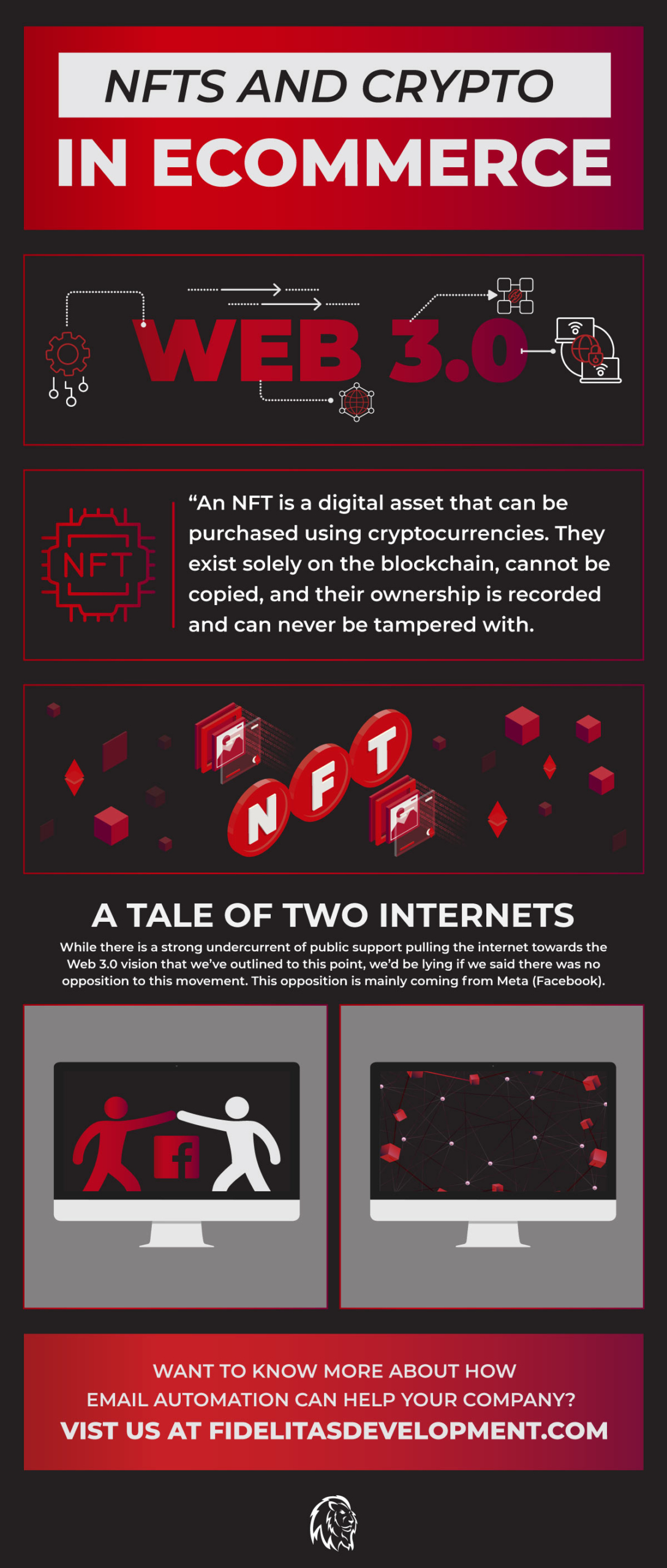NFT’s and Crypto in eCommerce
[ad_1]
Table of Contents:
What is Web 3.0?
What are Cryptocurrencies?
What are Non-Fungible Tokens (NFTs)?
What Web 3.0 Means for Marketers
Enhanced User Privacy
Using NFTs as a Marketing Tool
A Tale of Two Internets
Posturing Your Marketing for the Future
Web 3.0. Cryptocurrency. Non-Fungible Tokens…
These three buzz words dominated popular culture throughout 2021, and they seemed poised to grow in prominence in 2022. All three are a part of what is being referred to as “Web 3.0.”
Despite the fact that everyone from “tech bros” to marketing gurus has postured themselves as web 3.0 experts, it’s widely an uncharted sphere of tech. And it’s fair to say that nobody truly knows what the future holds for these new technologies.
That being said, we’re going to break down some of the predictions on how these new techs will fit into the wider marketing landscape as we move forward into the next phase of the internet. As well as how some of the world’s largest brands are leaping into the space.
Before we dive into the facts, and speculations, surrounding Web 3.0, and its related technologies, it’s best we give you a run-down of exactly what we’re talking about.
What is Web 3.0?
Web 3.0 is an umbrella term for a variety of technologies that are believed to be the future of the internet. Proponents of Web 3.0 believe that it’s the logical next step in the internet’s evolution. Before we discuss some of the defining features of Web 3.0, it’s best you have a thorough understanding of what Web 2.0 is.
Web 2.0: A Recap
The short answer is that Web 2.0 is the internet as we know it today. Web 2.0 has been characterized by the emergence of the FAANG tech bloc as well as other internet-centric businesses that have fundamentally altered the way that people interact with the world around them.
Web 2.0 has placed a very large emphasis on centralized control and content curation. In more recent years, more individuals have become aware of how highly curated their feeds are, and it has led to allegations that big tech has been suppressing media they disagree with via shadow bans and outright profile bans. Regardless of whether these claims are substantiated or not, it has driven a desire for more decentralized control of data on the internet.
What Will Web 3.0 Change?
The main change that Web 3.0 would provide is the decentralization of data. At a surface level, a decentralized internet would be an internet where applications like Facebook, Instagram, Youtube, and the like take a backseat to applications that aren’t controlled by a single corporate entity. Instead, web-based applications would be powered by peer-to-peer networks instead of a single controlled server.
What are Cryptocurrencies?
Blockchain and cryptocurrencies are other key aspects of decentralization. Digital currencies like Bitcoin, Ethereum, and Dogecoin have become staples of the move to a decentralized internet. These alternative forms of currency are seen as a way to move away from the central banks and fiat money.
The idea behind major cryptocurrencies is that government entities would have less control over currency. Currencies like Bitcoin have a finite quantity, and very specific conditions must be met to release more on the market. Of course, this lies in contrast to fiat money which can be printed, and therefore devalued, indefinitely. Theoretically, this would lessen inflationary pressures at the consumer level. Again, it’s impossible to say if this would be an accurate representation of reality.
Crypto’s Unstable Future
For any would-be crypto investors that are on the fence, one of the most important aspects of cryptocurrencies to consider is volatility. Just take a look at the value of Bitcoin over the past few months. Back in November 2021, Bitcoin was trading at over $60,000 USD. In May 2022, the value of the coin has plummeted by 50%. In fact, May has been a disastrous month for all cryptocurrencies. Even “stable-coins” have been rocked by industry-wide price crashes.
People who bought Bitcoin back before it went “to the moon” were probably very happy with their decision. But if they held onto it over the past 6 months they probably have buyer’s remorse. When it comes to crypto, you could make tens of thousands of dollars if you play your cards right, or you could wind up like the guy who spent 10,000 Bitcoins on two Papa John’s pizzas back in 2010…
The TL;DR is that cryptocurrencies are extremely volatile, and their value could skyrocket or plummet in a matter of minutes. So dumping your stocks in favor of crypto is probably not a great long-term investment plan.
What are Non-Fungible Tokens (NFTs)?
Non-Fungible Tokens, or NFTs for short, are another side of the crypto craze. An NFT is a digital asset that can be purchased using cryptocurrencies. They exist solely on the blockchain, cannot be copied, and their ownership is recorded and can never be tampered with.
NFTs exist on a spectrum. At the most basic level, an NFT is simply a digital image that you can own. These are the type of NFTs that critics typically think of. Those same critics point out that you can simply save the image to your computer while supporters argue that doing so is akin to having a fake Mona Lisa.
Monkey Business
On the other end of the spectrum, some businesses are finding ways to implement actual utilities into their NFTs. Bored Ape Yacht Club is the most prominent NFT with actual utility built-in. These NFTs launched back in April 2021,
they immediately soared in popularity with some apes currently selling for hundreds of thousands of dollars each.
So what makes Bored Ape Yacht Club different from other NFTs? Buying a Bored Ape gave owners access to a virtual hangout, exclusive NFT and Merch drops, and even exclusive events. Celebrities like NBA superstar Steph Curry and even Muli-Platinum rapper Eminem were quick to get their hands on Bored Apes.
But what makes them so valuable? It’s largely tied to a mix of personal sentiment and supply-demand. There are only 10,000 Bored Apes on the market, and the creators have no intentions of releasing more. They’re also seen as an exclusive status symbol, so giving up ownership naturally comes at a high price.
What NFTs and Crypto mean for eCommerce and Marketing
Web 3.0 is a giant umbrella term that encompasses a wide range of different technologies and topics. While each has the potential to impact marketers’ plans in major ways, there are a couple that we view as more prominent than the rest.
Enhanced User Privacy
Decentralization is one of the key facets of the vision for Web 3.0. In part, this means that privacy will play a key role as the internet continues to evolve. This is a reality that most digital marketers have already begun to realize.
While Google has temporarily postponed the death of the 3rd party cookie, the tech giant has shown no signs of backtracking on its decisions. This removal will mean that marketers will not only have a more difficult time targeting users with ads, but they’ll also have to grapple with a decreased ability to attribute conversions to their marketing efforts.
Meanwhile, Apple has continuously made changes that enhance user privacy. Back in 2019, Apple released a Safari update that blocked cookies by default. Apple’s marketplace dominance meant that marketers lost a significant portion of their targeting and attribution that year alone. However, iOS 15 was arguably the most frustrating update Apple has released to date. With the implementation of “Email Privacy Protection,” marketers lost the ability to reliably use open rates as a KPI and email tracking was effectively made obsolete.
These changes from Big Tech are just the beginning of the privacy overhaul that Web 3.0 promises to deliver. Marketers will have to find new KPIs to track their marketing efforts.
Using NFTs in eCommerce and Marketing
We already began delving into this topic in light detail earlier when we discussed the Bored Ape Society, but the use of NFTs as a marketing tool goes well beyond that niche group of wealthy elites. Massive consumer brands like Addidas and AB InBev are effectively using NFTs as part of a plan to build highly-engaged communities around their products.
Budweiser’s D-Wade Sponsorship
This story is hot off the press.
AB InBev brand Budweiser is no stranger to NFT collections at this point. In 2021, the beer behemoth released a collection of 1939 digital beer cans celebrating the brand’s heritage.
Now Budweiser is partnering with Dwayne Wade for the release of limited edition physical collectibles and NFTs to promote Budweiser Zero. These digital tokens will give their holders different tiers of rewards ranging from an NFT jersey all the way to an in-person experience with the Miami Heat legend himself.
According to an article from Adweek, the proceeds from the collection will go towards helping minority-run businesses in under-represented communities.
Considering how quickly Bud’s previous NFT collections have sold out, it’s a safe bet that this collection will garner a lot of support from NBA fans and beer enthusiasts alike.
Beer, Horses, and NFTs
The eSports scene is still relatively niche, even among the gaming community. But the NFT eSports scene is a new beast entirely, and it’s quickly gaining traction among those steeped in the metaverse. One game in particular, Zed Run, has been gradually growing in popularity over the past several years. Zed Run players can purchase—and “breed”—NFT horses to race against one another. AB InBev brand Stella Artios saw this as the perfect opportunity to put its product in front of a new audience.
While Stella is still hugely popular around the world, the brand has seen a fairly consistent decline in popularity over the past two decades. The brand needs to make itself relevant to a younger audience in order to continue thriving, and Zed Run already fits in with the brand’s history.
Stella Artois has a history of sponsoring horse races, so jumping into digital horse races seemed like a no-brainer. They created a set of NFT horses for Zed Run that were auctioned off. The horses were a hit and the most expensive NFT went for nearly $50k according to Zed Run.
Adidas NFTs
In December 2021, Adidas collaborated with NFT pioneers Bored Ape Yacht Club, Gmoney, and PUNKS Comic to release a limited-edition collection of 50,000 NFTs. Once the “Into the Metaverse” collection went on public sale, they were sold out within minutes.
What makes Adidas’ collection of NFTs different is the exclusive benefits that users receive for holding them. Anyone who owns a “phase 1” Adidas NFT can redeem it for exclusive physical merch and a “phase 2” NFT. The exclusive apparel items are completely free to NFT holders, but they must pay the Etherium gas fees required to mint the NFT.
While it’s unclear when Adidas will release its next collection of NFTs, it’s safe to say that they now understand the power of creating an inner circle for their community. After all, the cost of the free merch they’re sending to holders pales in comparison to the $22M they raked in off the sale.
A Tale of Two Internets
While there is a strong undercurrent of public support pulling the internet towards the Web 3.0 vision that we’ve outlined to this point, we’d be lying if we said there was no opposition to this movement. This opposition is mainly coming from Meta (Facebook).
Meta has a vision of the internet where it continues to reign as the top dog. While they aren’t technically calling this vision “Web 2.5,” I think it’s a fitting moniker. Because instead of a decentralized, private, and more anonymous internet, Meta is striving to make users more intertwined with their online personas.
The main vehicle for this is the Metaverse that Meta is creating. In this virtual reality, users will be able to recreate their homes, work with others in a virtual office, and create new experiences. Right now that involves wearing an Occulus Rift headset—but keep in mind that Meta will be releasing a new VR headset sometime this year.
The company’s ultimate goal is to create a set of Augmented Reality glasses that can overlap your physical world with virtual objects. How these changes will affect marketing, in the long run, is still unknown. But as brands position themselves for the transition away from traditional social media to Augmented Reality (AR) and Virtual Reality (VR) social media, it’s worth turning on Google alerts to keep up with the latest Metaverse news.
Posturing Your Marketing for the Future
There are some major changes in store for the marketing landscape. While it’s uncertain which vision of the internet will prevail, the best way to prepare is by building a future-proof marketing strategy. While we aren’t diving headfirst into NFT marketing just yet, Fidelitas can help you create a strategy to propel your business forward.
If you’re ready to develop a better marketing strategy, contact us today to learn how we can help your business.

[ad_2]
Source link












